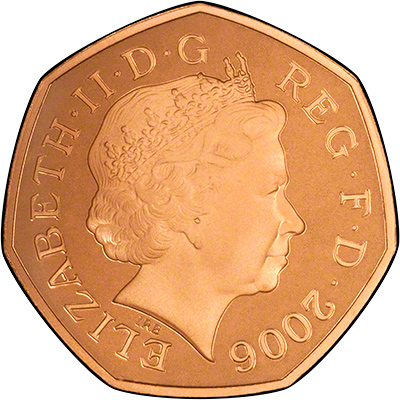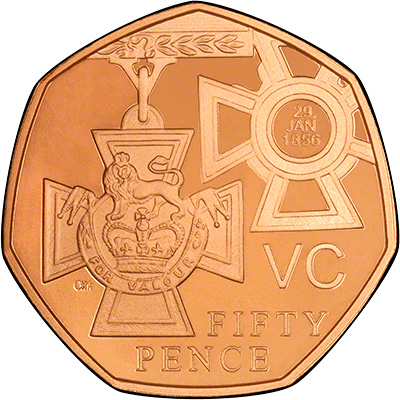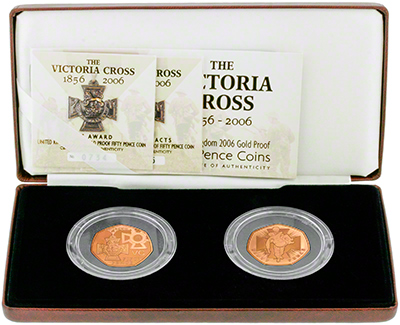2006 Fifty Pence Gold Proof - Victoria Cross
This year, the Royal Mint has decided to issue two different Fifty Pence coins both to commemorate the 150th anniversary of the Victoria Cross in 1856.The Victoria Cross
The Victoria Cross is the highest award for gallantry in the face of the enemy. All who have received it have shown conspicuous bravery, many at the cost of their own lives.The original idea for the Victoria Cross was proposed by the Duke of Newcastle in 1854 and the Royal Warrant for the creation of the medal was eventually signed by Queen Victoria at Buckingham Palace on 29th January 1856.
The first investiture took place on 26th June 1857 in Hyde Park where crowds gathered to witness the Queen, mounted on horseback, presenting medals to sailors and soldiers.
The Crimean War had taken place before the Cross was instituted but the earliest awards were made to sailors and soldiers who had fought in that war. Lieutenant Charles Lucas, who was serving the Royal Navy in the Baltic Sea in 1854, was the first person to be awarded the Cross. He received the VC for outstanding courage when he snatched up a live shell that had just landed on the deck of his ship, HMS Hecla, and tossed it overboard, saving the lives of the entire crew.
For Valour
The Victoria Cross was awarded much more regularly in the early years. In total 1,355 awards have been made since 1856. Since 1945 there have only been twelve awarded. The most recent award, announced in 2005, was to Private Johnson Beharry, The Princess of Wales's Royal Regiment.The Victoria Cross is given without regard to rank, race, colour or creed. All who have received this most prestigious of decorations are highly esteemed for their selflessness and their steadfast devotion to duty.
On the 5th of January 1856, the design of the Cross was approved by Queen Victoria with one amendment to the motto.
...For Valour rather than For the Brave, as this would lead to the inference that only those are deemed brave who have got the Cross.
The Award - Interesting Facts
- The youngest Victoria Cross recipient was A Fitzgibbon, Indian Medical Establishment, Taku Forts, China, August 1860, aged fifteen years three months.
- The oldest Victoria Cross recipient was Lieutenant W Raynor, Bengal Veteran Establishment, Indian Mutiny, May 1857, aged sixty-nine.
- There have been four instances of brothers being awarded the Victoria Cross.
- There have been three instances of father and son being awarded the Victoria Cross.
- The largest number of Victoria Crosses to be awarded in a single day was twenty-four at the second relief of Lucknow on 16th November 1857.
- The largest number of Victoria Crosses won in a single action was eleven at Rorke's Drift on 22nd January 1879.
- Since 1916, miniature Victoria Crosses have been worn with evening dress or mess dress in the place of full-size versions.
- Company Sergeant Major F W Hall, Acting Corporal L Clarke and Lieutenant R Shankland, who were all awarded the Victoria Cross in the First World War, all happened to live on Pine Street in Winnipeg, Manitoba, Canada. It is believed to be the only street in the world in which three VC recipients have lived. the name of the street was changed by the City of Winnipeg to Valour Street and a bronze plaque was mounted on a street lamp in honour of the three men.
The Medal
Since 1856, all VCs have been made by the London based jewellers Messrs. Hancocks and Co. The Crosses are made from bronze taken from cannon captured from the Russians during the battle of Sebastopol in 1854, at least according to the Royal Mint, and popular myth. A recently published book Bravest of the Brave by John Glanfield which claims to have exposed the truth about the metal used to make the awards. It has long been believed that all 1,351 Victoria Crosses awarded have been made of bronze taken from two Russian cannon captured at the siege of Sebastopol and kept in the Royal Arsenal at Woolwich.After the cross and the distinctive "V" shaped suspender are cast in the gunmetal and finished by hand, the medal and its components are chemically treated to achieve the characteristic dark brown colour. The design of the VC is generally thought to be the work of HH Armstead, but Queen Victoria herself suggested the inscription "For Valour". Originally the Cross had a red ribbon for the army and a blue ribbon for the Navy, but following the formation of the Royal Air Force in 1918, a single colour, red, was authorised for all recipients.Mystery Gunmetal
John Glanfield, a historian and author of Bravest of the Brave, to be published next month, claims to have exposed the truth about the metal used to make the awards. It has long been believed that all 1,351 Victoria Crosses awarded have been made of bronze taken from two Russian cannon captured at the siege of Sebastopol and kept in the Royal Arsenal at Woolwich. By studying historical documents and scientific analysis, Glanfield claims that the Woolwich cannon were not used until 1914, 58 years after the first Victoria Crosses had been produced. The precious ingot disappeared during the Second World War, so a different metal was used for five crosses awarded between 1942 and 1945. There was an accepted legend and no one had researched whether it was true. When something has been the belief for 150 years it becomes accepted as the truth. In the book, he says: "No aspect of the history of the Victoria Cross has been so hotly debated or disputed as the origin of the metal from which it is made. The truth has become fogged by time, myth and misinformation. Part of the myth is that every cross has been cast from the two [Woolwich] cannon. The cannon in Woolwich are Chinese-made, although they have often previously been cited as Russian, and Glanfield says that their origin is an "impenetrable mystery". He said there was no evidence that they had been captured at Sebastopol, the last big battle of the Crimean War, as was often stated. "The Chinese pieces were not the only, or even the first, to contribute VC metal," he said. "An earlier gun provided bronze from the start". "When the metal ran out in December 1914, the Chinese cannon took over. The football-size cascabels [knobs] were sawn off at the neck and melted down for VC production, starting not in 1856 but nearly 60 years and some 560 crosses later."
The Cross is inscribed with the recipient's name, rank, number, and the date of the act of valour. A second award is indicated by a bar worn on the ribbon above the medal. Three men have won the Victoria Cross twice; Lieutenant A Martin-Leake, Royal Army Medical Corps, Captain NG Chavasse MC MB, Royal Army Medical Corps, and Captain CH Upham, New Zealand Military Forces.
Obverse - Fourth Portrait
All 2006 coins carried the fourth portrait obverse design by Ian Rank-Broadley.Reverse
One design "The Award" bears a representation of the Victoria Cross itself, and was designed by Claire Aldridge. The other "The Heroic Acts" pictures a soldier carrying a wounded comrade "in the sort of act which would deserve the award", and was designed by Clive Duncan. An earlier version of this design was rejected by Chancellor Gordon Brown on grounds of taste, possibly because there would be some who would suggest that his stealth taxes had much in common with the rejected design which was similar to the final version, but with the cross hairs of a sniper's rifle sight trained on the back of the VC candidate.Specifications
| Diameter | Weight | Alloy | Gold Content |
|---|---|---|---|
|
27.30
|
15.50 grams | .9166 | 0.4600 Troy Ounces |
Notes on Table
Issue Price = Official Royal Mint issue price.Prices & Availability
2006 Gold Proof Fifty Pence 60th Anniversary of the VC - Medal
Quantity
Rate
Buy
Call to check availability
2006 Gold Proof Fifty Pence 60th Anniversary of the VC - Soldier
Quantity
Rate
Buy
Call to check availability
2006 Gold Proof Fifty Pence 60th Anniversary of the VC - Pair in Twin Box
Quantity
Rate
Buy
Call to check availability
You may wish to use our order form .
Postage & Packing
UK Registered Post (Special Delivery) £9 per orderEU Insured Post £10 per order
USA Airmail $10,
Insured Shipping $20
Canada Airmail $15,
Insured Shipping $30

Obverse of 2006 Victoria Cross Gold Proof Fifty Pence

Reverse of 2006 Victoria Cross 'The Award' Fifty Pence Gold Proof

Reverse of 2006 Victoria Cross 'Heroic Acts' Fifty Pence Gold Proof

Pair of 2006 Gold Proof Fifty Pences in Presentation Box
"Tax Free Gold" website is owned and operated by Chard (1964) Limited
32 - 36 Harrowside, Blackpool, Lancashire, FY4 1RJ, England. Telephone (44) - (0) 1253 - 343081; Fax 408058;
E-mail: Contact Us The URL for our main page is: taxfreegold.co.uk
32 - 36 Harrowside, Blackpool, Lancashire, FY4 1RJ, England. Telephone (44) - (0) 1253 - 343081; Fax 408058;
E-mail: Contact Us The URL for our main page is: taxfreegold.co.uk
